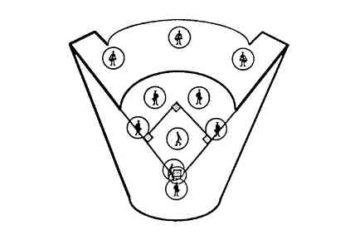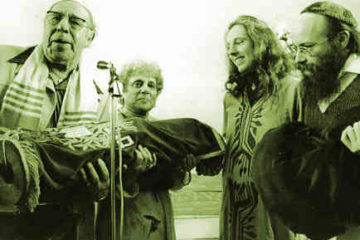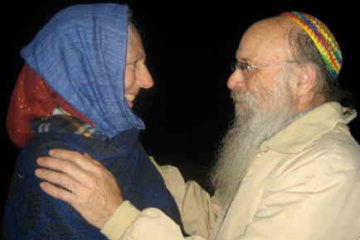This is an interesting essay. Essentially, it chronicles much of my growth in Yahidut (Judaism), from renewal to traditional observance, triggered, as is often the case, by a death in the family.

Gerry and Reuven Goldfarb
When he was laid to rest, I returned to my home and sat shiva. Friends from my community – the Aquarian Minyan – came to the house, offered their condolences, listened to my remarks and reminiscences, brought food and drink to share, and offered their support and understanding. Together we davenned Mincha and Ma’ariv (the afternoon and evening services), and those of us who were in mourning chanted the Kaddish.
When the week was over, I intended to continue saying Kaddish every day. There were three synagogues in our area which attempted to hold daily services. One was a liberal orthodox congregation to which I occasionally walked on Shabbat morning. Another was the local ChaBaD House, which I usually attended at least once during Passover for my mother’s Yahrzeit. The third was a middle-of-the-road Orthodox synagogue in Oakland – Beth Jacob – which had the best record for regularity and punctuality among the local minyanim.
After my mother had died, over four years before, I had found that I could always count on a minyan at Beth Jacob, both for Shacharit (morning prayers) and Mincha-Ma’ariv. Two of my friends had served as rabbi there (and been relieved of their duties). The present rabbi was a fine teacher and scholar, whose single session class in Jewish agricultural law I had attended at Berkeley Hillel.
For the first week after the funeral, I tried out the different minyanim, going to whichever seemed most convenient. My goal was to attend at least one service per day. Then a job I had been hoping for came through. I was hired to teach a Freshman English course at Merritt College, a two-year institution in Oakland. My class was scheduled from 8 to 8:50 a.m., Monday through Thursday. That pretty much decided where I would go on four of the weekdays, since Beth Jacob was the shul closest to my new place of work. Their Shacharit service began at 7 a.m. and ended either at 7:30, on an ordinary day, or at 7:45 if the Torah was read (Monday, Thursday, Rosh Chodesh – the new moon – and the intermediate days of festivals).
Since Merritt College was a closely predictable ten minutes from the shul, I was able to attend services in the morning and still make it to class on time. And so it was that I started attending Beth Jacob and became part of their minyan. My sister-in-law and I divided the mitzvah of saying Kaddish for Gerry, so that she went to Mincha-Ma’ariv near her home in Santa Monica, and I went to morning minyan at Beth Jacob in Oakland.
Within a few days I knew that I was going there not only to say Kaddish but also to carry out my other religious responsibilities by participating in a daily prayer service. For fifteen to twenty years I had been taking on the obligations of an observant Jew. My home community, the Aquarian Minyan, practiced an improvisational, free-form kind of Judaism that became more focused and structured (but not less joyous or profound) with each passing year. Our gatherings were usually held on Friday evenings, in celebration of Shabbat, and on all the other holidays of the Jewish year, from Rosh HaShanah to Tisha b’Av.
I had formed many close friendships in this group and was responsible for organizing many of its functions and sponsoring local appearances by several distinguished teachers: David Blank, Shlomo Carlebach, Dovid Din, Gedaliah Fleer, Meir Fund, Lynn Gottlieb, Avraham Greenbaum, Larry Kushner, Leah Novick, Jonathan Omer-man, Zalman Schachter-Shalomi (whose experiential seminars and Shabbatons back in 1974 had provided the original impetus for the group’s founding), Peninnah Schram, Michael Shapiro, Moshe Shur, Hanan Sills, Arthur Waskow, Gershon Winkler, David Zeller, and many others.
Our community, however, was not a “full service” synagogue. It did not have a weekday service, a Hebrew school, a rabbi who was on constant call for chaplaincy emergencies, a board of directors, and so on. I did have an affiliation with Temple Beth Abraham, a Conservative synagogue in Oakland, where my friend Joe Schonwald was the rabbi. I had sent my sons to its preschool and taught in their Hebrew School for two years when my sons were old enough to attend. (In the past, I had taught at four other Jewish schools as well, secular, reform, progressive, and conservative.) But I did not feel spiritually connected there. The creativity, the risk-taking, the sheer involvement of the Aquarian Minyan process was much more my speed. Now I would have to get used to something different.
Fortunately, the Bay Area is a friendly place, with an easy flow between different segments of the Jewish community and considerable cooperation between its different factions. Synagogues and community organizations often co-sponsor cultural and religious events, celebrating their unity and diversity. One of the minyanim my wife and I attended on Shabbat was comprised of regular members of other minyanim, who were not entirely satisfied with the style or tone of their usual davenning groups, along with several otherwise non-affiliated participants.
Yet until Gerry’s death, my personal practice did not involve attending a daily minyan. Even following my mother’s death, my attendance was irregular. I often davenned at home and, although I reached high levels of intensity and inspiration, I had no way to ground the energy. I might experience myself speaking directly to G-d, my words and pleas pouring forth in profusion for minutes on end, but might then collapse in exhaustion, or go directly to the kitchen and eat a hearty breakfast, after which I would need to rest. Often, after davenning and eating breakfast, I felt I had done a day’s work and found it difficult to be productive. And even at home, my motivation was not consistent. The most days in a row I had ever succeeded in putting on tefillin was three. Frequently, days would go by, even weeks, when – with the exception of Shabbat (a time I was usually with a minyan) – I could not bring myself to daven. I rationalized, declaring that instead I was performing gemilut chassadim – acts of lovingkindness (karma yoga, in Eastern terms) – but was never free of the nagging sense that I should be doing something more. At Beth Jacob, I began to find the fulfillment I had been missing.
The Beth Jacob minyan is a mixture of older and younger men. The oldest is Rabbi Mayer Goldberg, a cheerful Kabbalist of 96, who is still brimming with ideas and projects. (He recently published a collection of gematriot, citing seldom-noted numerical equivalents between different biblical Hebrew words and phrases.) The rabbi of the congregation, Howard Zack, a red-haired scholar in his mid-thirties, lives with his wife and daughters a short walk away. Most of the older men are refugees from Europe-Ernie Hollander, the deep-voiced gabbai; Sam Green, the plaintive Shaliach Tzibbur; Rabbi Yosef Samuel, the dignified and humble Baal Koreh, who always chants the Torah portion when it is read aloud; Ben-Tzion, the Shamash; and numerous others: Aaron Buder, Carl Friedman, Harry Jankovic, Sam Offen, David Stroessner, Menashe Taub, and some younger guys: Tim, Mal, Gene, Larry, Dean-and more recently, Paul, Jay, and Yefet.
Many of these regulars survived internment in lager – concentration camps. They commonly converse in Yiddish, a language more comfortable and home-like to them than the English they have learned as immigrants. Occasionally I can understand the gist of their remarks or catch a familiar phrase in their exchanges. I grew up in an English and Yiddish-speaking household, where my father and mother usually conversed in English, but broke into Yiddish when they wanted to keep their conversation confidential or when they spoke to certain other family members and friends. I was thus used to hearing Yiddish and liked the sound of it, even though I didn’t usually understand what was being said. Of course, my brother and I, if we sensed that some important information was being withheld from us, protested, demanding, “Speak English!” We were never formally initiated into mame-loshen (the mother tongue) – that is, we were never taught it systematically or spoken to in it with any expectation that we could reply. So, basically, I have a small vocabulary of Yiddish words and phrases. My first attempt at formal learning came at the hands of an anti-Chasidic secularist, whose sarcastic remarks about religion sabotaged the learning process for me.
When I first came to this minyan, after shiva had concluded, the members made room for me. Indeed, I had met some of them before, during my previous visits to the synagogue, but I had never become a regular, a fixture. Therefore, their greetings were friendly but not demonstrative. There was a subtle opening, a moving aside to allow me a place to stand, a helpful pointing toward the bookshelf, where the siddurim (prayer books) were located. When the Torah had been read the first time I was there, Yankel (Mr. Samuel, the Ba’al Koreh) turned to me and asked, “Are you going to help me?” which was his way of inviting me to perform hagbah, the lifting up of the open scroll.
“Of course,” I replied, and allowed myself to be summoned. When I gave my name, they realized I was a kohen (hereditary priest). After that, I was always called up to the Torah on Mondays and Thursdays, except on the rare occasions when a visiting kohen received the honor or if several mourners or individuals observing Yahrzeit for a near relative required an aliyah – while I stepped outside the small chapel, according to custom, to avoid a conflict of kavod (honor).
They exemplified a trait I like to call masculine reticence. We were all there for the same thing. There was no need to make a fuss about it. No one needed pumping up. Mild but earnest encouragement was all that was required. We came to pray, to daven. We needed each other to do it properly, so we belonged together. We were a self-selecting company of Jews.
At the same time, there was a gentleness and sweetness in their behavior and an underlying respect and love for one another. Most of these men had weathered great tragedies and changes of fortune. They had come to America, gone into business or entered a profession, raised a family-often a second family-and helped build a synagogue, maintaining and deepening their connection with Jewish life. They had continued the tradition of their parents and teachers, and continued to sanctify the Name of G-d through good times and evil times. They had earned a nurturing peace and equanimity through G-d’s blessings and by their own immense effort and patience.
There was always a coming and going of people who joined the minyan in order to say Kaddish or have an El molay rachamim prayer recited on the occasion of a parent’s or sibling’s or child’s Yahrzeit. They depended on the minyan’s continued existence but were not themselves prepared or able to directly support it by their continual presence. Some of them were members of the congregation; some were visitors to the area; others, like me, were local residents who were members elsewhere or who did not wish to join any synagogue. But synagogue membership was not required for minyan membership; attendance was the only qualification.
Many of the younger attendees – men in their thirties and forties – come to say Kaddish for eleven months. No one knows – they themselves don’t know – whether they will remain involved after their formal period of mourning is over. Perhaps it is a case of “many are called, but few are chosen”; in this case, “many are called, but few are choosing,” for it is a volitional act that determines one’s commitment when the primary obligation has ceased.
As for me, the obligation to say Kaddish has reinforced the equally significant obligation of praying with a minyan. And I intend to continue to carry out this obligation when, after eleven months have elapsed, the original motivation has ceased. And I hope to perpetuate my brother’s memory through acts of justice (tzedakah, including charity), deeds of lovingkindness (gemilut hasadim), and worship (avodah – holy work).
I will remember and thank him and thank G-d that through his death, I was enabled to return to a central Jewish precept. It will provide a further reason for believing that he did not live – or die – in vain.
Afterword
This article was originally completed in June 1990, shortly before the author left with his family for seven weeks in Israel. It was distributed to the members of the Beth Jacob daily minyan soon after his departure. Upon his return from Israel, where he had found a comparable synagogue near his apartment in Jerusalem, he resumed attending Beth Jacob on weekday mornings for several months, then began to attend less frequently. At the time of this article’s revision (August 1992), he has been going there regularly once again. His wife has also begun to join him on most mornings.
Postscript
The author’s father passed away in January of 1993. At that time he was grateful to have the support and good wishes of his fellow Beth Jacob Minyan attendees as well as that of his family and other friends. Two of the Minyan regulars have passed away and some others have ceased to attend regularly because of ill health. The inevitability of certain life cycle passages has brought others into the circle. – R.G., 1/23/95.
Post-postscript
As of this writing, three of the Minyan regulars have passed on:
Rabbi Mayer Goldberg, after a life of over 100 years;
David Stroessner, after being struck by a car while crossing a busy San Francisco street on his way home from a symphony concert;
Aaron Buder, a few weeks after the death of his second wife.
Each life is a coded history of the twentieth century, its roots extending back in time and its fruit anticipating the unrealized future. The author has, for the present, ceased attending the daily minyan. He is still involved with the Aquarian Minyan and Nishmat Shalom, an egalitarian traditional havurah with an emphasis on gender-inclusive language and values. – 3/16/97
Additional Note
Out of my experience with this minyan the following poem emerged:
MY PLATOON
At Lafayette, we stood and marched in
formation on the Quad, carrying
M-1 rifles, wearing olive-drab
woolen jackets and trousers, spit-shined shoes,
cotton khaki shirts, bright brass medallions,
and visored army caps.
John Pearl stood
beside me, mouthing off, his collar loose,
his tie askew, bellowing, “YES SIR!”
so everyone would know what he thought
of the army.
Now I stand in Minyan,
also ten, instead of a lieutenant,
a shaliach tzibbur to lead us in prayer.
I’m with an orthopedic surgeon,
a real estate broker, a scrap metal dealer,
a kosher food inspector, a hairdresser,
three rabbis, and a couple of retired guys.
We’re not marching in lockstep, swiveling
smartly in unison; no, we’re chanting
the words in the siddur, speeding up
and slowing down, each person sort of
keeping pace, lagging behind, then running
to catch up; on tip-toes for Kedushah,
head bowed for Tachanun, strong
in the responses for Kaddish, strong
on the amens and boruch hooz.
We’re like a platoon, a unit in an army.
We besiege the fortress of heaven with prayer;
We open the gates of our hearts to sing praise.
– 16 Tevet, 5758/January 14, 1998
Sequel
Since my wife’s mother’s death on February 27, she and I have both resumed attendance at the daily minyan, often at Beth Jacob and sometimes at Beth Israel, especially Sundays. An added enticement for Yehudit in regard to the latter site is that there often a Talmud shi’ur (lesson) following services which she enjoys sitting in on. I sometimes make my presence felt there as well. However, Beth Israel’s minyan begins at 6:30 am, a half hour earlier than Beth Jacob’s. On some days this presents a challenge, on others an opportunity. Both begin at 8 on Sundays. On another occasion I might take the time to describe the substantive and feeling-tone distinctions I observe between the various minyanim – orthodox, chasidic, renewal, feminist, conservative and reform – I have attended. However, that is a large task, one I am not prepared to undertake at present. – September 5, 1999
Continuance
Ernie Hollander (Yisrael Eliahu ben Zev Meir v’Shaindel), a descendant of Rabbi Solomon Ganzfried and a passionate and articulate survivor of the European Khorban, was niftar on 13 Menachem-Av, 5762 (July 21, 2002). May his memory be for a blessing!
– circulated to the JourneysJournal list on 8 Menachem-Av, 5763 (August 6, 2003), the 14th Yahrzeit of my brother Gerald, Ya’akov ben Shaya HaKohen v’Reizl
Subsequent Note
An abbreviated version of this memoir was published in the National Jewish Post and Opinion. Volume 69, Number 56, 20 Elul, 5763/September 17, 2002. The above poem, “My Platoon,” which first appeared in Kol Yakov,” the newsletter of Congregation Beth Jacob, won a Commendation Award from the Chester H. Jones Foundation’s National Poetry Competition in 1998 and was published in its annual anthology. It was later reprinted in View from the Seventh Floor, the Writers Catalog of the Arad Arts Project 2000.
1
An excerpted version of “Masculine Reticence” appeared in The National Jewish Post & Opinion


